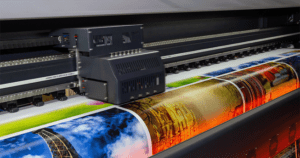Navigating Different Types of Commercial Printing

The landscape of commercial printing services is diverse. Whether launching a marketing campaign, promoting your company at an event, updating your branding, or simply conveying information, understanding which commercial printing services best suit your project can make all the difference. In this post, we break down the types of commercial printing and their applications to help you make informed decisions.
Offset Printing: The Mark of Craftsmanship
Offset printing produces high-quality color and consistency on the widest variety of paper stocks. It’s ideal for large-scale marketing campaigns, high-end catalogs, or extensive corporate literature. This type of commercial printing requires significant setup time and materials. Creating plates, calibrating the press, and preparing inks are part of the initial setup before printing a single page. Regardless of whether you print 1,000 or 100,000 pieces, these initial costs are the same, so they are more economically distributed over larger print runs. Use offset printing for runs of 2,000 or more and allow a longer turnaround time.
When seeking an offset printing resource, look for a G7-certified printer. G7 is the gold standard for achieving superior color accuracy and consistent quality throughout your print run and with your color proofs.
Digital Printing: Direct Imaging
Digital printers use direct imaging technology, sending digital images directly to a printer to produce a printed piece. Depending on your requirements, you have two choices for digital printing.
- Inkjet Printers: Inkjet printers reproduce your design by propelling ink droplets onto the paper or substrate in a precise pattern. These printers can produce color matching that rivals offset printing, print black and color simultaneously, and print on various formats and substrates. Inkjet printers are best for high-quality, colorful materials in quantities less than 2,000.
- Laser printers: Using a laser beam to project the image onto an electrically charged rotating drum, a toner (powdered ink) is attracted to the charged areas to form the image and transfer it onto paper. They produce materials at a greater speed and lower cost than an inkjet printer. However, the color matching is not as precise as inkjet prints, so save this for text-heavy materials like operation manuals and letters.
Variable Data Digital Printing: Where Personalization Meets Efficiency
Digital printing’s ability to perform variable data printing (VDP) is one of its most significant advantages over offset printing. Unlike offset printing, changing the image for each piece doesn’t require any additional physical setup of the printing process. Therefore, text, graphics, and pictures can be changed from one printed piece to another without slowing the printing process.
Digital printing offers flexibility with variable data printing for organizations looking to personalize communication. You can tailor each printed piece to the recipient, making it ideal for benefit statements, utility bills, or insurance documents.
Note: Verify your printer has SOC 2 / HITRUST certification to guarantee the highest level of security and privacy, which is crucial for handling sensitive personal information.
 Wide Format Printing: Make a Big Impact
Wide Format Printing: Make a Big Impact
When size and visibility are crucial, wide-format printing is your answer. Wide-format prints are designed to stand out and are custom-made to fit a variety of sizes and shapes. Exceeding the standard printing sizes offered by traditional printing presses, wide format typically starts at 18 inches wide and can go up to 100 inches or more. It employs various printing technologies, most commonly inkjet, to produce large graphics suitable for numerous applications.
- Signage: Large signs designed to catch the eye of passersby near and far.
- Standees: Great for photo opportunities, standees are popular event decor.
- Point of Purchase (POP) Displays: Retail stores use wide format printing to create eye-catching in-store displays that promote products or sales.
- Trade Show Graphics: Banners, displays, and other promotional materials for trade shows are often large and sometimes irregularly shaped, making wide-format printing necessary.
- Window Graphics: Businesses use wide format printing to create window clings and decals for promotions or decoration.
- Wall Murals: Creating large murals for interior or exterior decor can create an engaging space for visitors and employees.
- Floor Graphics: Print directional signage or advertising directly onto floor vinyl, which is durable and slip resistant.
- Architectural and Engineering Drawings: Detailed large-scale drawings for construction and engineering projects are printed using wide format printers for clarity and readability.
Final Thoughts and the Fineline Advantage
When choosing a print partner, consider your project’s quantity, quality, personalization, and scale. By selecting a service that aligns with these factors, your printed materials will reflect the professionalism and dynamic nature of your brand.
Are you ready to bring your business’s printing needs to life? At Fineline, we are a “right-sized”, minority commercial print partner. We have the capacity and expertise to cater to Fortune 500 companies ensuring your print requirements meet the highest quality standards. Yet, we remain agile and flexible, ready to adapt to quick turnarounds and evolving priorities of any business. Fineline is SOC2 Type 2 Certified to meet all your compliance needs and is G7 Certified.
Contact us for a quote on your commercial printing and gain a partner who understands your vision and can deliver exceptional results.
